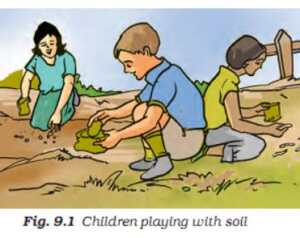Paheli Boojho Chapter 9 Class 7 science Soil:
I wonder why I found some pieces of plastic articles and polythene bags in the soil sample collected from the roadside and the garden.

Answer: Almost all things get degraded by nature. E.g. fruits, vegetables, cereals, paper, wood etc. But certain things do not degrade in nature. Plastic particles and polythenes are such particles. We call them non-biodegradable substances. When these substances come into the soil, they exist for thousands of years. People use plastic and polythene bags to carry their belongings and through. This trash goes into nature and is deposited into the soil.
I have seen pots and toys made up of soil in haat (bazaar)
Q. Boojho imagines the pots and toys made up of soil.
Answer: This remark explains some usage of the soil and use of products made from the soil instead of plastics. Soil finds its use in earthen pots and clay toys. These are alternatives to plastic toys and also do not pollute nature.
I want to know: What kind of soil should be used for making earthen pots (matkas and surahis)?
Q. Boojho want to know the answer.
Answer: Clayey soils are soil with fine soil particles. Clayman easily shapes them into useful items like matkas and surahis.
Boojho wondered why there was a difference in the absorption of water in the two squares.
Answer: Boojho dropped water from a bottle onto the house floor and again on a pagdandi and saw that water is absorbed more on the pagdandi/kaccha road. This happens due to differences in the percolation rate of different soils. Hou’s lawn is impermeable to waste. So, water does not percolate through these.
Pagdandi/kaccha road contain soil particles. Water percolates from these particles. As a result, they absorb water.
What is the difference between rate of percolation and the amount of water retained? Boojho, you seem to have forgotten what you read earlier. Go and reread the lesson again and you will find the answer.
Answer: Boojho does not know the difference between them both. Here is the answer:
Percolation is the rate at which water passes through the material. Here water is not held.
Amount of water retails: Every soil has some water holding capacity. This is the amount which the soil can hold into it. Percolation starts when water is more than the water holding capacity of the soil.
Read also:
Paheli Boojho Chapter 8 Class 7 science
Paheli Boojho Chapter 7 Class 7 science
Paheli Boojho Chapter 6 Class 7 science
Paheli Boojho Acids Bases & Salt Class 7 Science
Other Paheli Boojho chapters from Class 7 Science
You might be interested:
Class 7 Activities Explanation
Chapter PDF:
Winds, Storms and CyclonesmPDF book: CBSEwire